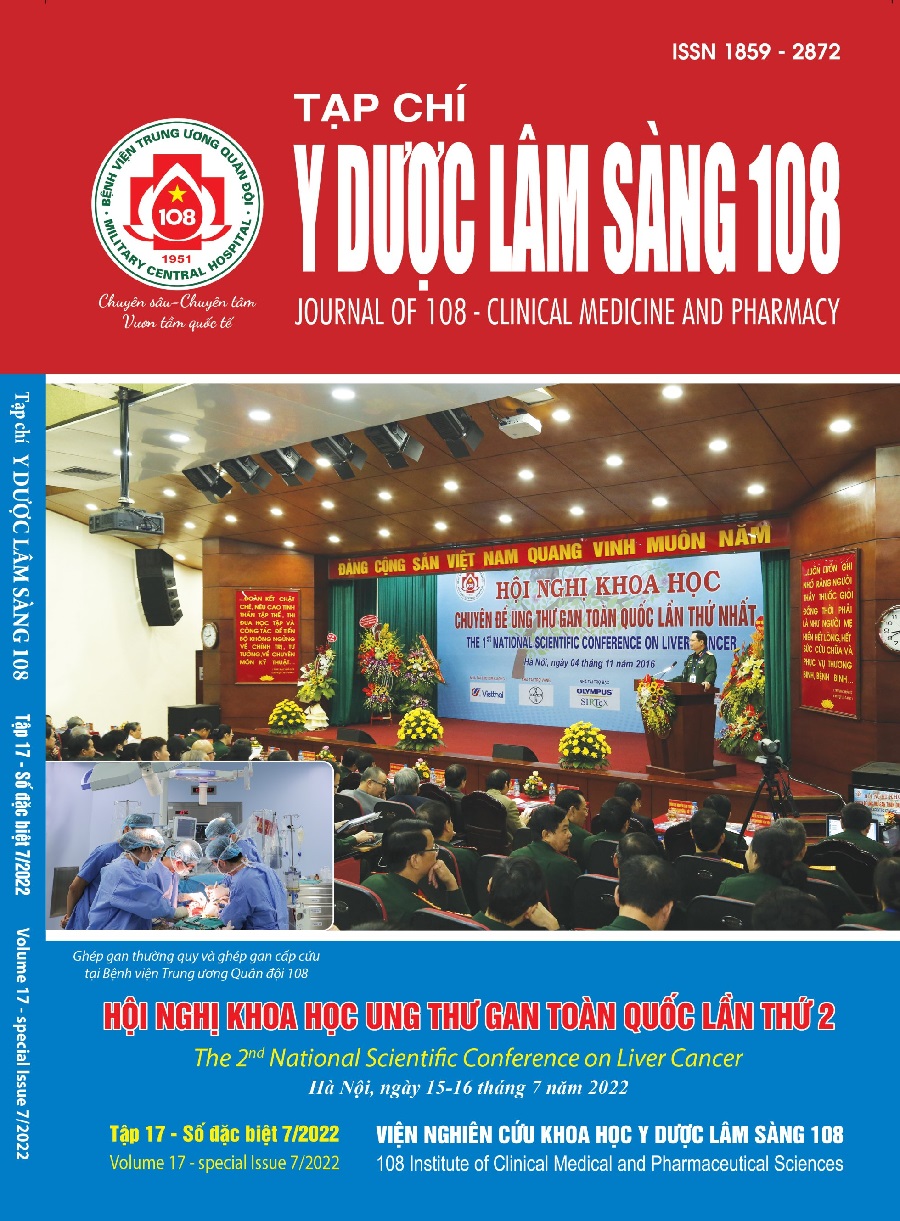Clinical and bone scintigraphy characteristics in patients with hepatocellular carcinoma
Main Article Content
Keywords
Abstract
Objective: To evaluate clinical, laboratory features and relationship with bone metastasis among hepatocellular carcinoma (HCC) patients. Subject and method: A cross-sectional study was done on HCC patients treated at the 108 Military Central Hospital, from 7/2012 to 7/2015. Patients underwent the whole body bone scintigraphy about 3 hours after the intravenous injection of 15mCi of Tc-99m methylene diphosphonate. Result: 65 patients were recruited, including 58 males and 7 females, Mean age was 59 ± 12 years, range from 30 - 83 years old. The clinical symptoms including upper quadrant right pain, loss of appetite, bloating dyspepsia accounted for high percentage 95.4%, 86.5%, 86.5% respectively. The rate of patients with serum AFP ≥ 300UI/ml was 36.9%. The rate of patients who had slight elevation of liver enzymes and bilirubin level accounted for from 73.8 to 84.6%. Most patients had ≥ 2 tumors located in the right lobe or both lobes of liver. 76.6% of cases had tumor ≥ 3cm, portal vein thrombosis accounted for 49.2%. Bone metastases accounted for 32.3%, Bone lesions mainly located in vertebral columm and hip bones. Patients with serum AFP ≥ 300UI/ml had higher rate of bone metastasis compared with patients who had AFP < 300UI/ml. Conclusion: Bone metastasis is common among HCC patients and related to elevation of serum AFP ≥ 300UI/ml.
Article Details
References
2. Bartel, Twyla B et al (2018) SNMMI Procedure Standard for Bone Scintigraphy 4.0. Journal of Nuclear Medicine Technology 46(4): 398-404.
3. Chih-Yu Chen, Yong-Te Hsueh, Tsung-Yu Lan et al (2010) Pelvic skeletal metastasis of hepatocellular carcinoma with sarcomatous change: A case report. Diagnostic Pathology 5: 33.
4. Gupta V (2005) Bone scintigraphy in the evaluation of cancer. Kathmandu University Medical Journal 3(11): 243-248
5. Hai-yan Chen, Xiu-mei Ma, Yong-rui Bai (2012) Radiographic characteristics of bone metastases from hepatocellular carcinoma. Contemp Oncol (Pozn) 16(5): 424-431.
6. Harding JJ, Abu-Zeinah G, Chou JF et al (2018) Frequency, morbidity, and mortality of bone metastases in advanced hepatocellular carcinoma. J Natl Compr Canc Netw 16(1): 50.
7. Hirohisa Katagiri, Mitsuru Takahashi, Jiro Inagaki, et al (1999) Determining the site of the primary cancer in patients with skeletal metastasis of unknown origin. Cancer 86(3): 533-537.
8. Ji Eun Lee, Jae Young Jang, Soung Won Jeong, (2012) Diagnostic value for extrahepatic metastases of hepatocellular carcinoma in positron emission tomography/computed tomography scan. World J Gastroenterol 18(23): 2979-2987.
9. Sangwon Kim, Mison Chun, Heejung Wang, et al (2007) Bone metastasis from primary hepatocellular carcinoma: Characteristics of soft tissue formation. Cancer Res Treat 39(3): 104-108
10. Tadashi Terada, Hirotoshi Maruo (2013) Unusual extrahepatic metastatic sites from hepatocellular carcinoma. Int J Clin Exp Pathol 6(5): 816-820.
11. Wang X, Liu J, Chen J, Li Y, Li Y (2016) Early detection of metastases by bone scintigraphy in patients with hepatocellular carcinoma. J Liver 5: 191. doi:10.4172/2167-0889.1000191.
12. Yang H, Liu T, Wang X, Deng S (2011) Diagnosis of bone metastases: a meta-analysis comparing 18FDG PET, CT, MRI and bone scintigraphy. Medicine European Radiology, DOI:10.1007/s00330-011-2221-4 Corpus ID: 324870.
 ISSN: 1859 - 2872
ISSN: 1859 - 2872
